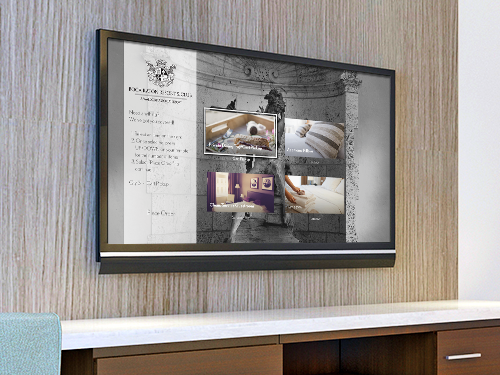
By Kris Singleton, President and CIO of Enseo - 2.11.2022
Throughout the pandemic, hotels have struggled to meet guest expectations and needs while addressing staffing shortages and sanitation and safety concerns. If anything has become clear in the hospitality industry post-pandemic, it’s that there’s no going back to meeting guest expectations the pre-pandemic way. Feedback from hoteliers indicates that guest returning to travel have higher expectations now than before COVID-19. Guests want all the perks they had before the pandemic in addition to an increased level of value and experience.
For starters, adopting technology to ensure guest comfort and safety is critical to balancing customer needs with hotelier limitations. We’ll highlight three areas where hoteliers can focus their technology efforts to take the guest experience to new heights: automation, communication, and personalization and staffing optimization.
Automation and the Convenience of Self-Service
Industry data shows that hospitality’s struggles with staffing will continue for the foreseeable future. Hoteliers and workers are adjusting to the realities of a leaner workforce. In this new environment, automation is no longer a nice-to-have. It is a must. The goal is not to replace staff, but to automate basic tasks via technology, making staff more efficient, and enabling them to focus on what they do best: serving guests.
Rather than heading to the front desk to checkout, guests can use their TV to checkout or, download an app or web app on their mobile device to put in requests that get incorporated directly into housekeeping and engineering automated workflow streams.
Communication
Hotels are known for inventing new ways to surprise and delight customers. One of the most important features guests have come to expect is simply a matter of proactively keeping them in the loop, updating them on changes, or introducing new options in clear, accessible ways. For example, in response to staffing limitations, hoteliers spun negative situations into positive experiences, with more purpose driven visits to drop off amenities or provide smaller housekeeping services (maybe not changing sheets every night or vacuuming the carpet but, a “light” clean, such as picking up trash and dropping off towels).
From a health and safety perspective, communicating the do’s and don’ts, and local or regional COVID-19 protocols is extremely important to manage guests’ expectations once on property. Is the restaurant setup for dining in? Is it now a grab and go? Where are masks required? Can they use various meal delivery solutions? Even providing updated information about local attractions and what is or isn’t available has become a new challenge.
For the communication of safety steps and protocols, leaning on digital signage methods means meeting the guest where they are and how they want to be communicated with. Hotels have installed more screens than ever before, including TVs, guest-facing smart devices and a suite of other interactive devices like the in-room thermostat.
Personalization and Staffing Optimization
Many hotel chains have worked hard on their mobile applications and rewards programs. These systems became key players in streamlining check-in/out, billing, and even in some cases, keyless entry during the height of COVID-19’s low occupancy impacts. I personally experienced a wide variety of these implementations as both a traveling guest and an industry insider.
These experiences established new relationships with customers, gaining access to a lot of unique user data, and arguably building a foundation to expand automated services. Utilizing CRM for personalization and marketing automation can, at the very least, reach guests through various levels of targeted marketing.
Direct and targeted marketing only scratch the surface of maintaining guest satisfaction. With more advanced technology endpoints in the guest room, hoteliers have the opportunity to automate unique experiences. Using previously mined guest data, they can ensure their room is set to a comfortable temperature, the TV is stacked with plenty of streaming options, and have extra towels on hand if that’s what they like. All these little things mean a lot to the guest.
Opportunities for Excellence
As the pandemic shifts from being more endemic than epidemic, hotels are in a prime position to listen, learn, and gather feedback on what their guests expect and need. Technology today offers a wide array of options to ease travel woes and communicate expectations and policies.
Real Hospitality is about turning one-time guests to reoccurring guests by providing them with the best customer service and convenience. It’s a very simple concept easily executed with the right suite of technology in place. Technology that makes it possible for already strained hoteliers to provide every guest with unique not standard experiences that can’t (or won’t) want to get anywhere else.
 Kris Singleton is President and CIO of Enseo, the premier provider of customer experience technology in the U.S., offering solutions in hospitality and other industry sectors. Enseo has been engineering innovative hardware and software solutions for 21 years that deliver digital entertainment, managed WiFi, smart room automation (IoT) and energy management, and a suite of health & safety solutions. A 30-year veteran of the technology industry, she has more than a decade of experience in gaming, hospitality and travel, and has held CIO positions for Omni Hotels & Resorts, The Cosmopolitan of Las Vegas, Kimpton Hotels & Restaurants, and International Cruise & Excursions.
Kris Singleton is President and CIO of Enseo, the premier provider of customer experience technology in the U.S., offering solutions in hospitality and other industry sectors. Enseo has been engineering innovative hardware and software solutions for 21 years that deliver digital entertainment, managed WiFi, smart room automation (IoT) and energy management, and a suite of health & safety solutions. A 30-year veteran of the technology industry, she has more than a decade of experience in gaming, hospitality and travel, and has held CIO positions for Omni Hotels & Resorts, The Cosmopolitan of Las Vegas, Kimpton Hotels & Restaurants, and International Cruise & Excursions.
Are you an industry thought leader with a point of view on hotel technology that you would like to share with our readers? If so, we invite you to review our editorial guidelines and submit your article for publishing consideration.
